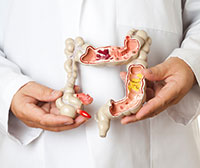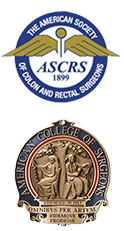Diagnostic Tests

Anoscopy
Anoscopy is a diagnostic examination of the anus and lower rectum performed in the office using a small rigid instrument called an anoscope. Anoscopy is used to evaluate diseases of the anorectal region such as hemorrhoids, fissures, fistulas, inflammation and some tumors.
Flexible Sigmoidoscopy
Flexible sigmoidoscopy is an outpatient or office-based procedure using a long, flexible tubular instrument to view the inner lining of the lower large intestine/colon and rectum. A biopsy can also be taken if necessary through the instrument.
Usually an enema is given 2 hours prior to the procedure at home. No sedation is required. The procedure takes 5-10 minutes.
Flexible sigmoidoscopy is commonly used to evaluate gastrointestinal symptoms such as pain, bleeding or change in bowel habits. It can also detect polyps or cancer.
Colonoscopy
 A colonoscopy is a common procedure in which the doctor examines the entire inner lining of the large intestine, which includes the colon and rectum. It is used to diagnose colon and rectal problems and to perform biopsies or removed colorectal polyps. These polyps can gradually transform into cancer over a period of years. Removing the polyps will reduce or prevent someone from getting colon cancer.
A colonoscopy is a common procedure in which the doctor examines the entire inner lining of the large intestine, which includes the colon and rectum. It is used to diagnose colon and rectal problems and to perform biopsies or removed colorectal polyps. These polyps can gradually transform into cancer over a period of years. Removing the polyps will reduce or prevent someone from getting colon cancer.
Why is a colonoscopy ordered?
The most common reason for having a colonoscopy is screening of the large intestine for colon and rectal cancer. Everyone at or over the age of 50, without any risk for polyps and cancer, should have a screening colonoscopy. If you have risk factors for colon cancer, such as a family history, your doctor may recommend earlier colonoscopy. African Americans have a higher risk and death rate from colon cancer than any other ethnic group. The exact reason isn’t known. African Americans should begin screening colonoscopy at the age of 45 rather than the age of 50.
Additional reasons for a colonoscopy include:
- Unexplained abdominal symptoms
- Anemia or low blood count
- Blood in the stool, hidden or obvious
- Diarrhea
- Change in bowel habits
- Suspected Inflammatory bowel disease such as Ulcerative Colitis or Crohn’s disease
How does one prepare for a colonoscopy?
If you ask anyone who’s gone through a colonoscopy, they’ll probably tell you the procedure is relatively easy but the day before the procedure was the hardest. Read through the complete instructions and information concerning your colonoscopy and the bowel prep at least one week before the colonoscopy. Make sure all information and instructions are understood before starting the bowel preparation. Remaining on a clear liquid diet the day before the colonoscopy and completing the bowel preparation solution are the greatest challenges to undergoing a colonoscopy. The prep simply doesn’t taste very good, however, cleaning the colon is an absolutely critical part of an effective procedure. The bowel prep is a prescription medicine your doctor gives to you to prepare your colon for inspection during a colonoscopy. The goal of the bowel prep is to remove all solid waste from the colon for the best evaluation. Without a clean colon, a thorough examination of the colon becomes much more difficult for the doctor. Additionally, it is essential to stay well hydrated while doing the bowel prep as you need to replace the fluids you’re losing, so drink plenty of clear liquids.
What happens the day of the procedure?
Since you will be sedated for the colonoscopy, you may eat or drink anything the morning of the procedure. The exception to this rule is if you have important blood pressure medications or other medications to take in the morning. They may be taken with a small sip of water.
On arrival to the facility, you will be asked to change into a hospital gown and an IV will be started. You will then be wheeled into the procedure room. When the procedure is ready to begin you will be asked to roll over so you are lying on your left side. Sedation will be given through an IV in your hand or arm. The most common method of sedation for a colonoscopy puts you into a sleepy, dreamlike state to make sure you are comfortable during the procedure. The medication is very short acting so as soon as it stops being administered you wake up very quickly with minimal side effects or hang over effects.
During the course of your colonoscopy, if your doctor sees a polyp or other growth or lesion, it will be removed through the colonoscope. The entire procedure usually takes less than half an hour. Afterwards, you are in the recovery room for 30-45 minutes. Your doctor will speak with you regarding the results of your colonoscopy. Because of the sedation, you will need someone to drive you home.
What happens after the colonoscopy?
After the colonoscopy, you will need a ride home. Most people prefer to rest after having a colonoscopy since they may not have had much sleep while doing the bowel prep. You may eat what you like, unless specifically instructed otherwise by your doctor. You are asked not to drive, operate heavy machinery, make any major legal or financial decisions the day you have had a colonoscopy. The following day life can resume as usual. If any biopsies were taken during the procedure, you will be called with the results in a few days. Should you develop any abdominal pain, fevers, chills or have any questions whatsoever please call the office for immediate attention.
 For more information on our Diagnostic Tests, or to schedule an appointment, please complete our online form or call 410-573-1699.
For more information on our Diagnostic Tests, or to schedule an appointment, please complete our online form or call 410-573-1699.





